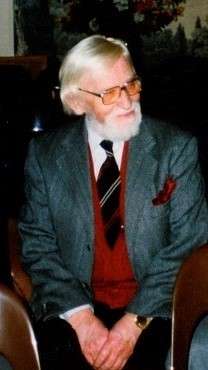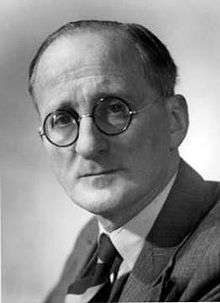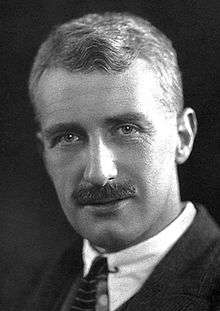Esther Simpson
Esther Simpson (31 July 1903 – 19 November 1996) was appointed the assistant secretary for the Academic Assistance Council (AAC) in 1933. She worked tirelessly throughout her life to establish work and connection for refugees in need. Her work was essential to some of the finest projects and she worked with some of the world's greatest scientific minds, many of whom participated in the Manhattan Project.

She was awarded the OBE in 1956 and received honorary degrees from the University of London and the University of Leeds in 1981 and 1989 respectively.[1]
Esther Simpson, known as Tess to her friends, is best known for being a devoted and noble lobbyist and organizer for the Academic Assistance Council. Working closely with other scholarly immigrants such as Leo Szilard, she assisted hundreds of refugees of high academic calibre during the difficult time that was World War II and placed them in different work positions all over the world. She lived and worked throughout Europe with various organizations to promote the acceptance of refugees under the tensions that arose from the Nazi regime and later other global conflicts.
Early life
Esther Simpson, born as Esther Sinovitch, was born on July 31, 1903, in Leeds, Yorkshire, to Jewish parents. She was the youngest of her four siblings and was raised in a lower-middle-class family.[2] Her parents were immigrants from Russia who were very young when they moved to Leeds to escape the pogroms. Her father supported the family working in a garment factory. She attended the Leeds Girls' Modern School and the University of Leeds from 1921 to 1925 on a scholarship where she not only took a first class degree in Modern Languages but also gained a first in her program.[3] Simpson was fluent in German and French, in addition to her native English.
After graduating from university, she spent a few years in Europe, first working as a governess for a wealthy family in Germany then spent a short period in Paris. She then accepted a job at the International Fellowship of Reconciliation in Vienna where she worked for a few years. Following this, she briefly worked for the World Alliance of the YMCA in Geneva in 1933. In the summer of the same year, she accepted a lower paying job offered by the Academic Assistance Council (later the Society of Protection of Science and Learning), as she believed she could make a valuable contribution there.
Personal life

Simpson's birth name was Esther Sinovitch but she changed her name on August 21, 1933, one month after she had started to track people with alien status and whose names were being communicated to native Britons, identified due to being foreign-sounding.[3]
Simpson was deeply attached to her work and never married or had children. Simpson's friends recall her as someone who had a general concern for humanity. Simpson understood the importance of assisting refugee scholars and was dedicated to her work. She was known as Miss Simpson to strangers, Esther to colleagues, and Tess to her close friends.[2]
Simpson's life-long passion was music and she was a gifted violinist. From a young age, Simpson developed a love for music and she started violin lessons at nine years old. She obtained certificates and medals from the Leeds College of music for violin before she entered the University in 1921.[4] Simpson developed her craft and became an amateur of professional standard. Many professionals were delighted to play with her, such as Max Rostal, a world-renowned violinist. Music was a big part of her life; she said: "Music enriched my life by providing me with wonderful friends – meeting a musician was so often like a pebble cast in a pool whose ripples go on to eternity."[5]
Career
Academic Assistance Council and Society for Protection of Science and Learning
In the summer of 1933, while Simpson was living in Geneva, she was hired as an assistant secretary and then later became the administrator and executive assistant of the Academic Assistance Council (AAC) as it was called at the time, through Leo Szilard. The AAC was helping academics fleeing from the Nazi regime by offering them grants and aiding them to find new employment around the world.[6] The organization was fundamental in organizing support for these refugees as well as the integral lobbying against xenophobia in Britain at the time. The AAC was established at the London School of Economics through William Beveridge, who learned of the dismissal of academics and students from Germany during his time in Vienna.
At the outbreak of the war in 1939, Simpson managed to register around 2,000 scholars.[7] By the 1940s, the AAC was renamed to the Society for the Protection of Science and Learning (SPSL) and was great being led by Simpson. At this point, they were working to aid the refugee scholars confirmed as aliens, who were interned by the British government, in addition to their work with the refugee scholars who were fleeing Nazi Germany and the Nazi-occupied European territories.[6]
Simpson was vital in processing the application forms that the SPSL received. The forms asked for various details, such as personal details, income, academic qualifications, language proficiency, and where they would prefer to go if they end up being considered. Simpson would then decide whether scholars were worthy and if so, she would then arrange all the details for the move and provide any other assistance.[3] Furthermore, she would organize tours to the United States by offering them grants for their travels and according to personal accounts, they were often offered work immediately after their travels.
The refugee scholars were dispersed over various continents through the Society, particularly throughout Britain and Commonwealth countries.[8] Simpson struggled to place academics in various disciplines, such as law, history, and art history. Some disciplines were more popular, which meant more employment opportunities, particularly in the discipline of science.[9] Simpson did manage to place some academics in the field of art history in curator positions. They also struggled to place German refugee scholars, as they had German educations, which were less preferred than those educated in Britain.[10] In 1940, Simpson was responsible for drawing up a list of over 550 candidates who were being interned in Britain, to be set free.[11]
Simpson was committed to her job and worked overtime, until late in the evenings, even at the start in her lower position when she was receiving a third of her previous salary. She believed there was no time for holidays; her first holiday since beginning her work with the Society was in 1951.[2] She was essential in carrying out the daily work of the organization in her position as the administrator.[12] Simpson was also vital in communications between the refugee scholars and the organization, as she was responsible in writing letters and keeping up with correspondence, writing tens of thousands of letters during her time there.[2]
Simpson's efforts were not only limited to the assistance of relocating refugees and finding them suitable work. She began lobbying and encouraging support for refugees that were held at detentions centres by the British government. The xenophobic sentiments at the time were congruent with the inaccessibility of assimilation by these refugees and a reluctance to provide them with equal opportunity. One of the leading figures in studying the science of language, Otto Neurath was briefly interned at one of these centres in the British Isles. It was Simpson and her work that successfully guaranteed his release in 1941. Upon his release like many others, Neurath was able to begin conducting his own research and work in some of the most accomplished institutions.[3]
Post–World War II
At the end of the war, Simpson continued her work with the AAC, particularly in finding where the scholars who had not escaped were located.[13] This meant not only helping the survivors of the war find new homes but also advising the friends and family of the scholars who had not survived their fate. She was dedicated to reuniting these academics with their families, as she considered the people she helped to be her family.
In 1944, Esther Simpson left the SPSL and accepted a job as the assistant secretary for the Society for Visiting Scientists. She worked at the SVS from 1944 to 1966. A couple of years later in 1951, she continued her job at the Society for Visiting Scientists but started doing volunteer work for the SPSL. She later joined the SPSL full time again in the mid-1960s. A colleague of hers wrote, "though Hitler was dead, intolerance went on."[3] She later aided refugees fleeing from Eastern Europe with the Stalinist regimes in the USSR, as well as refugees fleeing the regimes in South Africa, Chile, and Argentina.
Simpson was greatly devoted to her position and work with the SPSL. She was quick to aid the refugees due to her belief that human relationships were the most important and was idealized by many due to her work. She believes her upbringing as a child of immigrants in Britain allowed her to be more critical, and therefore successful in her work[14] She was aware that refugee organizations would not be able to do everything, but she wanted to help in any way that she could.[2]
Esther's children
Throughout her life, Esther Simpson helped save many hundreds of lives, of scientists, philosophers, historians, artists, musicians and architects, who would go on to contribute immeasurably to intellectual and cultural life throughout the globe. In 1983, Simpson created a list of all the refugee scholars and their children, who were saved through the SPSL, who went on to receive distinctions. The list contained 16 Nobel Prize Laureates, 80 fellows of the Royal Society, and 34 fellows of the British Academy, among others. Many others who did not receive distinctions still contributed to knowledge, culture, education and learning in Britain, the United States, and all over the world.[3]
- Some of Esther's Children




She formed friendships with many of her "children", including famous violinist Max Rostal and was the only amateur to be tutored under him. She regularly had supper with Nikolaus Pevsner, who brought new perspectives on the UK's architectural heritage to scholars and the wider public. A.V. Hill, who won a Nobel Prize in Physiology and Medicine, had 40 years of correspondence with Tess. Additionally, Ludwig Guttmann, who went on to found the Paralympics, and Max Perutz, a molecular biologist who won a Nobel Prize, had correspondence with her.
It is also during her time working for the Society that Simpson became a friend and confidant of Engelbert Broda, an Austrian chemist. Her correspondences with him were less formal than those with other refugee scholars. They managed their friendship even though they had different political views, being that Broda was a communist.[15]
Additionally, the scholars she saved cared deeply for her. At her retirement party, which was attended by lords, knights, and professors, money was donated to Simpson, who had worked at a small salary and did not have savings, to help her with retirement.[3] Not only did they raise enough money to buy her a flat, but letters poured in as well from Australia, the US, Canada, Japan, Germany, Austria, Switzerland, Israel and elsewhere, expressing gratitude and love.
Until her death, Esther Simpson would walk to the local shop every day to get a newspaper and The Times to cut out clippings of the work her "children" were doing around the world.[2]
Awards and achievements
In 1949 the French government awarded her the Ordre des Palmes Académiques and she became an Officer d'Académie. She then went on to receive the Order of the British Empire (OBE) in 1956.[16]She also received an LLD (Doctorate of Laws) from the University of London in 1981 and at her alma mater, the University of Leeds in 1989.[4] She received an honorary membership at the Royal College of Physicians in Britain in 1991 and according to the Registrar at the time of appointment, he said: "the honour can seldom go to a more deserving person."[5]
In January 2020 Leeds University announced that the new building in the schools of law and business studies due to open in 2021 will be named the Esther Simpson Building.[17]
Later life and death
Esther Simpson continued playing music, in particular, the violin and viola, until her deafness worsened in her seventies.[3]
In 1992, Simpson collaborated with Ray Cooper to create the book "Refugee Scholars: Conversations with Tess Simpson". The book is an informal recount of her life and career. Max Perutz and Sir Ernst Gombrich assisted and attended her book launch.
She passed away on November 19, 1996, at age 93.[5] She donated all her correspondence, letters, clippings, and documents she collected throughout her life to the University of Leeds Archives.[4] In her will and last testament, she specified to have her flat donated to charity.[3]
References
- "Grace under Pressure" (19). University of Leeds. January 2018.
- Weydner, Sara (July 24, 2018). "BBC-Documentary 'Miss Simpson's Children': How a Woman Ran a Refugee Organisation". The London Moment.
- Edmonds, David (May 11, 2017). "Esther Simpson - the Unknown Heroine". The Jewish Chronicle.
- "Esther Simpson correspondence and papers". Library | University of Leeds. Retrieved 2019-03-12.
- Medawar, Jean; Pyke, David (December 4, 1996). "Obituary: Esther Simpson". The Independent. Retrieved March 12, 2019.
- Zimmerman, David (March 2006). "The Society for the Protection of Science and Learning and the Politicization of British Science in the 1930s". Minerva. 44 (1): 24–45. doi:10.1007/s11024-005-5405-8.
- Holfter, Gisela, and Horst Dickel. An Irish Sanctuary German-speaking Refugees in Ireland 1933–1945. Berlin: De Gruyter Oldenbourg, 2018.
- Rider, Robin E (1984). "Alarm and Opportunity: Emigration of Mathematicians and Physicists to Britain and the United States, 1933-1945". Historical Studies in the Physical Sciences. 15 (1): 107–76. doi:10.2307/27757544.
- Starr-Egger, Felicitas M (May 22, 2017). "7 Women Refugee Academics at the University of London". Exile and Gender II: Politics, Education and the Arts: 96–113. doi:10.1163/9789004343528_009.
- Star-Egger 106
- Seabrook, Jeremy. The Refuge and the Fortress Britain and the Flight from Tyranny. Basingstoke: Palgrave Macmillan, 2009.
- Holtfer 271
- Zimmerman, p. 44
- Seabrook, Jeremy. The Refuge and the Fortress Britain and the Flight from Tyranny. Basingstoke: Palgrave Macmillan, 2009.
- Seabrook 67
- "No. 40669". The London Gazette (Supplement). 30 December 1955. p. 15.
- "Fitting tribute to 'true inspiration'". Leeds University. 28 January 2020. Retrieved 28 January 2020.
Bibliography
- Brinson, Charmian, Jana Burešová, and Andrea Hammel. Exile and Gender II: Politics, Education and the Arts. Leiden: Brill Rodopi, 2017.
- Edmonds, David (May 11, 2017). "Esther Simpson - the Unknown Heroine". The Jewish Chronicle.
- Hoch, Paul K (March 10, 1983). "The Reception of Central European Refugee Physicists of the 1930s: U.S.S.R., U.K., U.S.A"". Annals of Science. 40 (3): 217–46. doi:10.1080/00033798300200211.
- Holfter, Gisela and Horst Dickel. An Irish Sanctuary German-speaking Refugees in Ireland 1933–1945. Berlin: De Gruyter Oldenbourg, 2018.
- Jean Medawar; David Pike (December 24, 1996). "Obituary: Esther Simpson". The Independent.
- Rall, Jack A (2017). "Nobel Laureate A. V. Hill and the Refugee Scholars, 1933–1945". Advances in Physiology Education. 41 (2): 248–59. doi:10.1152/advan.00181.2016.
- Rider, Robin E (1984). "Alarm and Opportunity: Emigration of Mathematicians and Physicists to Britain and the United States, 1933–1945". Historical Studies in the Physical Sciences. 15 (1): 107–76. doi:10.2307/27757544.
- Seabrook, Jeremy. The Refuge and the Fortress Britain and the Flight from Tyranny. Basingstoke: Palgrave Macmillan, 2009.
- Snowman, Daniel. The Hitler Emigres: The Cultural Impact on Britain of Refugees from Nazism. London: Pimlico, 2013.
- Starr-Egger, Felicitas M (May 22, 2017). "7 Women Refugee Academics at the University of London". Exile and Gender II: Politics, Education and the Arts: 96–113. doi:10.1163/9789004343528_009.
- "Politics and Social History". University of Leeds.
- Weydner, Sara (July 24, 2018). "BBC-Documentary 'Miss Simpson's Children' How a Woman Ran a Refugee Organisation". The London Moment.
- Zimmerman, David (March 2006). "The Society for the Protection of Science and Learning and the Politicization of British Science in the 1930s". Minerva. 44 (1): 25–45. doi:10.1007/s11024-005-5405-8.
- Zimmerman, David (June 2007). "'Narrow-Minded People': Canadian Universities and the Academic Refugee Crises, 1933–1941". Canadian Historical Review. 88 (2): 291–315. doi:10.3138/chr.88.2.291.